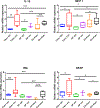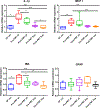Neuroinflammation in Murine Cirrhosis Is Dependent on the Gut Microbiome and Is Attenuated by Fecal Transplant
- PMID: 31220352
- PMCID: PMC6923631
- DOI: 10.1002/hep.30827
Neuroinflammation in Murine Cirrhosis Is Dependent on the Gut Microbiome and Is Attenuated by Fecal Transplant
Abstract
Cirrhosis and hepatic encephalopathy (HE) is associated with an altered gut-liver-brain axis. Fecal microbial transplant (FMT) after antibiotics improves outcomes in HE, but the impact on brain function is unclear. The aim of this study is to determine the effect of colonization using human donors in germ-free (GF) mice on the gut-liver-brain axis. GF and conventional mice were made cirrhotic using carbon tetrachloride and compared with controls in GF and conventional state. Additional GF mice were colonized with stool from controls (Ctrl-Hum) and patients with cirrhosis (Cirr-Hum). Stools from patients with HE cirrhosis after antibiotics were pooled (pre-FMT). Stools from the same patients 15 days after FMT from a healthy donor were also pooled (post-FMT). Sterile supernatants were created from pre-FMT and post-FMT samples. GF mice were colonized using stools/sterile supernatants. For all mice, frontal cortex, liver, and small/large intestines were collected. Cortical inflammation, synaptic plasticity and gamma-aminobutyric acid (GABA) signaling, and liver inflammation and intestinal 16s ribosomal RNA microbiota sequencing were performed. Conventional cirrhotic mice had higher degrees of neuroinflammation, microglial/glial activation, GABA signaling, and intestinal dysbiosis compared with other groups. Cirr-Hum mice had greater neuroinflammation, microglial/glial activation, and GABA signaling and lower synaptic plasticity compared with Ctrl-Hum mice. This was associated with greater dysbiosis but no change in liver histology. Pre-FMT material colonization was associated with neuroinflammation and microglial activation and dysbiosis, which was reduced significantly with post-FMT samples. Sterile pre-FMT and post-FMT supernatants did not affect brain parameters. Liver inflammation was unaffected. Conclusion: Fecal microbial colonization from patients with cirrhosis results in higher degrees of neuroinflammation and activation of GABAergic and neuronal activation in mice regardless of cirrhosis compared with those from healthy humans. Reduction in neuroinflammation by using samples from post-FMT patients to colonize GF mice shows a direct effect of fecal microbiota independent of active liver inflammation or injury.
© 2019 by the American Association for the Study of Liver Diseases.
Figures











Similar articles
-
Intestinal inflammation and microbiota modulation impact cochlear function: emerging insights in gut-ear axis.Cell Commun Signal. 2025 Jul 26;23(1):357. doi: 10.1186/s12964-025-02338-1. Cell Commun Signal. 2025. PMID: 40713718 Free PMC article.
-
Microbiota transplant for hepatic encephalopathy in cirrhosis: The THEMATIC trial.J Hepatol. 2025 Jul;83(1):81-91. doi: 10.1016/j.jhep.2024.12.047. Epub 2025 Jan 10. J Hepatol. 2025. PMID: 39800192 Clinical Trial.
-
Fecal microbiota transplantation for the treatment of recurrent Clostridioides difficile (Clostridium difficile).Cochrane Database Syst Rev. 2023 Apr 25;4(4):CD013871. doi: 10.1002/14651858.CD013871.pub2. Cochrane Database Syst Rev. 2023. PMID: 37096495 Free PMC article.
-
Gut microbiota links to histological damage in chronic HBV infection patients and aggravates fibrosis via fecal microbiota transplantation in mice.Microbiol Spectr. 2025 Aug 5;13(8):e0076425. doi: 10.1128/spectrum.00764-25. Epub 2025 Jul 11. Microbiol Spectr. 2025. PMID: 40642988 Free PMC article.
-
Synbiotics, prebiotics and probiotics for people with chronic kidney disease.Cochrane Database Syst Rev. 2023 Oct 23;10(10):CD013631. doi: 10.1002/14651858.CD013631.pub2. Cochrane Database Syst Rev. 2023. PMID: 37870148 Free PMC article.
Cited by
-
Fecal microbiota transplantation: A promising treatment strategy for chronic liver disease.World J Gastroenterol. 2025 Jul 28;31(28):105089. doi: 10.3748/wjg.v31.i28.105089. World J Gastroenterol. 2025. PMID: 40741477 Free PMC article. Review.
-
Risk of dementia or cognitive impairment in non-alcoholic fatty liver disease: A systematic review and meta-analysis.Front Aging Neurosci. 2022 Sep 20;14:985109. doi: 10.3389/fnagi.2022.985109. eCollection 2022. Front Aging Neurosci. 2022. PMID: 36204558 Free PMC article.
-
Infection, inflammation and hepatic encephalopathy from a clinical perspective.Metab Brain Dis. 2024 Dec;39(8):1689-1703. doi: 10.1007/s11011-024-01402-y. Epub 2024 Aug 30. Metab Brain Dis. 2024. PMID: 39212845 Free PMC article. Review.
-
Regulating Intestinal Microbiota in the Prevention and Treatment of Alcohol-Related Liver Disease.Can J Gastroenterol Hepatol. 2020 Dec 17;2020:6629196. doi: 10.1155/2020/6629196. eCollection 2020. Can J Gastroenterol Hepatol. 2020. PMID: 33381475 Free PMC article. Review.
-
The microbiota in cirrhosis and its role in hepatic decompensation.J Hepatol. 2021 Jul;75 Suppl 1(Suppl 1):S67-S81. doi: 10.1016/j.jhep.2020.11.013. J Hepatol. 2021. PMID: 34039493 Free PMC article. Review.
References
-
- Riggio O, Ridola L, Pasquale C, Nardelli S, Pentassuglio I, Moscucci F, Merli M. Evidence of persistent cognitive impairment after resolution of overt hepatic encephalopathy. Clin Gastroenterol Hepatol 2011;9:181–183. - PubMed
-
- Bajaj JS, Sanyal AJ, Bell D, Gilles H, Heuman DM. Predictors of the recurrence of hepatic encephalopathy in lactulose-treated patients. Aliment Pharmacol Ther 2010;31:1012–1017. - PubMed
-
- Vilstrup H, Amodio P, Bajaj J, Cordoba J, Ferenci P, Mullen KD, Weissenborn K, et al. Hepatic encephalopathy in chronic liver disease: 2014 Practice Guideline by the American Association for the Study of Liver Diseases and the European Association for the Study of the Liver. Hepatology 2014;60:715–735. - PubMed
Publication types
MeSH terms
Grants and funding
- P40 OD010995/OD/NIH HHS/United States
- P30 DK034987/DK/NIDDK NIH HHS/United States
- I01 CX001076/CX/CSRD VA/United States
- I01 BX001390/BX/BLRD VA/United States
- R01 MH111940/MH/NIMH NIH HHS/United States
- R01 DK087913/DK/NIDDK NIH HHS/United States
- R01 MH084894/MH/NIMH NIH HHS/United States
- P30 DK056350/DK/NIDDK NIH HHS/United States
- R56 MH084894/MH/NIMH NIH HHS/United States
- R01 DK115377/DK/NIDDK NIH HHS/United States
- R21 TR002024/TR/NCATS NIH HHS/United States
- I01 BX004033/BX/BLRD VA/United States
- P30 ES010126/ES/NIEHS NIH HHS/United States
- I01 BX001328/BX/BLRD VA/United States
- P01 DK094779/DK/NIDDK NIH HHS/United States
- R21 AA026629/AA/NIAAA NIH HHS/United States
- IK6 BX004477/BX/BLRD VA/United States
- R01 DK104893/DK/NIDDK NIH HHS/United States
- R01 DK057543/DK/NIDDK NIH HHS/United States
LinkOut - more resources
Full Text Sources
Medical

